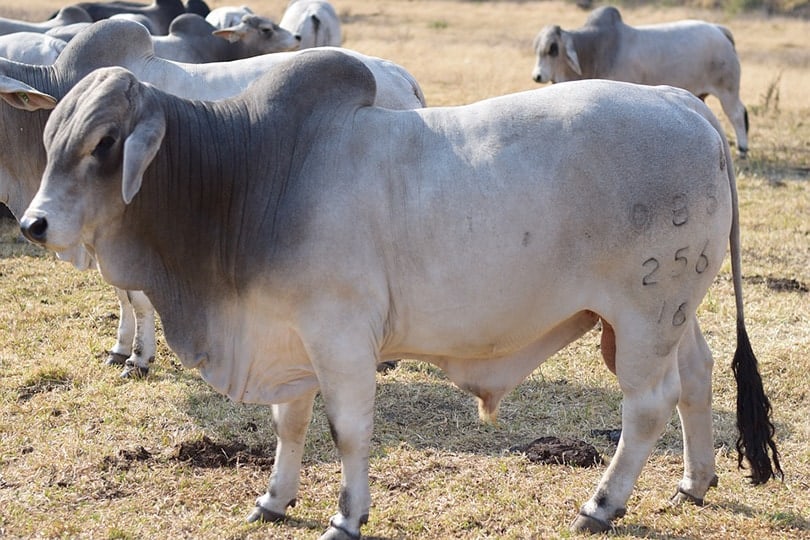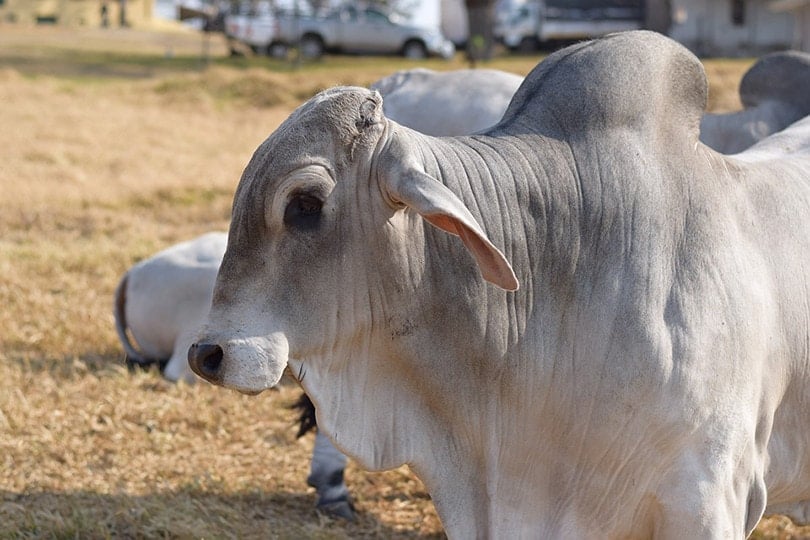You come across a lot of cattle living in America. Whether you walk into a cattle barn at the local county fair or are on a cross-country road trip, there are some cows that clearly stand out among the rest. The Brahman cattle breed is absolutely beautiful and recognizable by the large hump on their backs. They may not be the most popular cattle in the U.S., but they are still popular and vital to the meat and dairy industries. Even if you don’t know all that much about cattle, this breed is a great start to understanding these huge animals.
Quick Facts about Brahman Cattle

| Breed Name: | Bos taurus indicus |
| Place of Origin: | India |
| Uses: | Breeding, beef, dairy |
| Bull (Male) Size: | 1,600 – 2,200 pounds |
| Cow (Female) Size: | 1,000 – 1,400 pounds |
| Color: | Grey, brown, red, black |
| Lifespan: | 15 – 20 years |
| Climate Tolerance: | Temperatures as low as 8°F |
| Care Level: | Intermediate |
| Production: | Beef, dairy |
Brahman Cattle Origins
The Brahman cattle originated from India and have become known as “sacred cattle” there. For hundreds of years, these cows had to deal with many harsh conditions that have created some of the most remarkable cattle adaptations.
These Indian cattle were first brought into the United States around 1885 and were primarily used for breeding. They are strong, hardy animals with a high tolerance to heat, sun, cold, and humidity. Today, the Brahman breed has become essential in many countries worldwide because they have adapted well to so many different climates.
Brahman Cattle Characteristics
The stand-out feature of Brahman cattle is the large hump that sits on top of their shoulder and necks. They have evolved to have an abundance of loose skin on their bodies, which scientists believe is to help them withstand hotter temperatures. They also have a higher number of sweat glands that allow them to sweat freely.
Most Brahman cattle are an intermediate size compared to other beef breeds. Most bulls weigh between 1,600 and 2,200 pounds, with females only weighing between 1,000 and 1,400 pounds.
These cattle are intelligent but shy. Still, they are adaptable and very hardy by being able to live off a wide range of foods and different climates. Most handlers love to work with them because they are very docile.
Uses
The most common uses for the Brahman cattle breed are breeding, meat production, and dairy production. Females have high milk flow compared to others than tend to decline in adverse conditions. Their meat also has minimum fat.
Breeders enjoy these cattle because they tend to be of good quality, strong, and disease-free. They are also readily available in all parts of the world.

Appearance & Varieties
Brahmans come in various colors, with most being light grey, red, brown, or black. Many breed members seem to be light to medium gray. Mature bulls usually have dark areas around their shoulder, lower thighs, and neck compared to younger ones.
The fur on a Brahman is thick, short, and glossy to reflect the sun’s rays off their almost black, pigmented skin. Their horns also curve upwards. Their heads are long in size, with a giant hunchback on their neck and shoulders.
Population
These animals are not wild and are almost always kept as livestock. They are most commonly used in Argentina, Paraguay, Brazil, Australia, Colombia, and the United States. They are one of the most popular breeds in the entire world.
It’s hard to say how many Brahman cattle there are in the United States today. Because they were used for crossbreeding, many cattle contain some percentage of Brahman DNA. What we do know is that there were approximately 93.8 million cattle in the United States in 2020 alone.
Are Brahman Cattle Good for Small-scale Farming?
Brahman cattle are excellent to use on a farm, but they might be a bit much to handle for smaller-scale operations. Brahman breeds are larger in size and require more land. They have very high milk production rates and fertility rates. Without the space of resources, you could find that you aren’t able to keep up with the demands of these animals.

Final Thoughts
Aside from in major cities, it’s common to come across cattle while living here in the United States. Brahman cattle are everywhere. Even if they aren’t purebred, they have been used in crossbreeding for generations, and most of today’s livestock has a small portion of Brahman DNA. They are treasured in the meat and dairy industry, but they are also gentle and beautiful animals to interact with.
- You may also be interested in: Droughtmaster Cattle
Featured Image Credit: Shayaden, Pixabay
